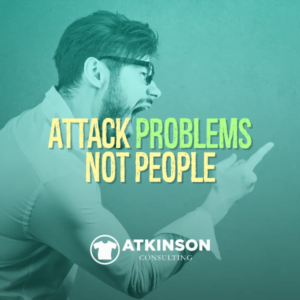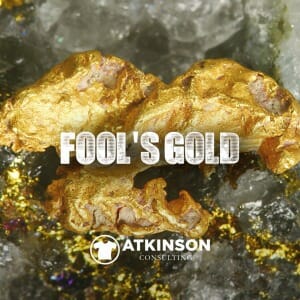ThreadX19 in San Diego was a smashing success at generating an avalanche of ideas and networking opportunities for garment decorators.
During the last three days, I asked many attendees, “Why are you here?”. I got basically two answers from about twenty-five or so people that I polled.
“I’m here to be part of my community of decorators and network.”
and
“I’m searching for new ideas and perspectives.”
I was in both mental models.
ThreadX is not a how-to conference. Instead, it is a “what-if” conference.
You should be leaving the event with a full notebook of ideas and a pocketful of business cards and new connections. I know I did.
ThreadX is about possibilities as presented by your Tribe.
To that end, I thought I would share some of the best takeaways from the event.
Buckle up, there is a lot to cover from this incredible event.
ThreadX: Ubuntu
The first fantastic idea out of the gate was from dynamo moderator riCardo Crespo. This is the notion of Ubuntu.
Ubuntu is a South African word that means this phrase:
“I am. Because we are.”
This idea is about community and belonging. It is the notion that I won’t let you down because we are the same.
One mind.
Together.
Ubuntu is a powerful message and a great example was the way that Boston Celtics coach Doc Rivers used to unite the team on their championship run in the 2010-2011 season.
For folks in the decorated apparel industry, we should stop and consider this notion and how we can use it to our advantage. Not just in our shops, but in our supply chain network, industry associations, and thought leaders.
When we come together and elevate our creative hive-mind we can become more powerful.
We need more connectedness. Less fracture.
“I am. Because we are.”
How can you use Ubuntu in what you are doing?
ThreadX: Engagement
Throughout many of the ThreadX presentations, multiple people expressed different angles on the notion of Engagement. Whether it is with your customers, employees, community, or even family…the choices that are made have an effect. Even not doing something has an effect.
riCardo Crespo spoke eloquently about how it doesn’t matter how many thousands of social media connections you have if you aren’t actively engaged with them, they are simply vanity metrics. He says for customers or social media connections, “The value of your brand is determined by the quality of how you are engaging with them.”
Another speaker, Charles Ohiaeri, the Chief Fulfillment Officer for Zazzle, expressed another thought in that you need to “establish a language you can execute on.” One of the notions that I thought was great in his presentation was that “Making Matters”, and that the story around making things is often overlooked. “People assume that it’s always there.”
Which means that you need to be telling the story of making things.
Building a Bridge
riCardo advised building a bridge toward them. This happens with you actively reaching out and trying to gain alignment. “Can you tell the story of how and why of what you do?”
Many shops don’t.
They list that they can print with quality. That they have great customer service. A design team.
Who cares?
That’s not creating alignment with your customers. Probably not even with your employees. Just like a movie trailer, your story is building a promise of what is to come.
Truly exceptional brands show us “Why” they are. riCardo said, “Your brand is the collective of the perceptions and expectations of your audience that are validated by their desired experience.”
Which means that your brand is only what your audience says it is.
Not what you say it is.
Your shop is remembered by the last crappy thing that happened to your customer. It’s how you treat your employees. Your vendors.
Engage
When people come across your shop, they are looking for engagement. The first step in merely observational.
What are you offering that is worthwhile?
Because what they perceive as good or bad has a direct link to your reputation. It is what separates you from your competition. If you are consistently awesome, that proves your culture and adds to your story.
riCardo says to remember that, “Your story, your culture, your DNA are giving them the trigger words to use in their own story about you. Your story is the “Why” that may resonate with someone. People will cross that bridge to you if you resonate and align with them.”
Therefore are you trying to engage with people by offering features and benefits, or maybe crazy used car salesman-like SALES!
Or, are you working on connections? Culture? Influence? Welcoming them to the Tribe?
People want to move toward a community. To something better.
Can you treat them like a human being?
“Trends happen in a community space. Don’t compete on SKU vs SKU.”, says Crespo.
Who is in your Tribe?
Repeat
How people talk about you when you are not around is your “Reputation Equity”. The work you present is perceived subjectively.
When you are consistently delivering on the story of your business, and then creating that engagement, then people will be coming back to you for more. Frankly, because so many other companies fail to deliver on that promise.
That builds trust. That’s why people will pay more for that value.
Branding creates those relationships. Marketing connects those relationships. Sales nurture those relationships.
But Returns start questioning the relationships. Any time there is a problem, that person starts down a negative road.
“Why am I here?”
Remember, you have to have a direct answer to that question. Are you involved? Or is it radio silence?
Ohiaeri with Zazzle has a good take on this too, “Your rule structure for working needs to be seamless.” It simply has to work. When something goes wrong, who is at fault? Your customer or your employee…or you as the business owner because it wasn’t thought through well enough and is easy?
Your engagement is the cement in that relationship.
Ohiaeri says, “Are you delivering confidence along the way?”
Never underestimate the power of “Made for You”.
ThreadX: Together is Better
Speaking of engagement, that theme resonated with a few other speakers as well.
Ryan Moor sang about it with a song, “Together is Better”.
[av_video src=’https://vimeo.com/318499865′ mobile_image=” attachment=” attachment_size=” format=’16-9′ width=’16’ height=’9′ conditional_play=” av_uid=’av-uxlkpg’]
Plus, Brian Adam with the Olympus Group talked at length about employee engagement. A few of the attendees that I spoke with later said it was the favorite part of the ThreadX event.
His presentation was essentially built around the idea of Peter Drucker’s famous quote, “Culture eats strategy for breakfast.” Engaged employees do better work.
But how do you create that engagement? That’s the trick.
On that end, and because he’s a fan of David Letterman, he created a Top 10 List for employee engagement.
Top 10 List for Employee Engagement
- Create a Noble Mission
- Culture Deck – Netflix
- New Employee Orientations – 1st Day
- Hey Brian! Program
- One Year One-On-Ones
- Monday Morning Updates
- Personal Goals
- Result Presentations
- Profit Is Not A Dirty Word
- Make It Personal – Give Away The House
Let’s break those down:
Create A Noble Mission
This is that old tried and true Mission Statement work. As mentioned before, it’s the “Why” that drives your company.
They took a hard look at their antiquated Mission Statement and revised it to be incredibly more powerful. At a retreat, they realized that engaged and challenged employees will deliver better results.
Therefore, they removed any discussion on their market, customers, profit goals, and other ideas and focused on only one idea. “To create a rewarding work environment for our employees.”
That’s it.
Talk about driving company culture. It’s their Mission Statement!
When they adopted this strategy they went from $11m in sales in 2015 to $35m in sales in 2018.
Culture Deck – Netflix
At Olympus, they don’t mind borrowing great ideas from other companies. One such is the Culture Deck from Netflix.
Do yourself a favor and make time to go through that slide deck and compare that to how you run your shop.
Doesn’t this inspire you to make some changes?
What Adam liked about this was that it created “alignment from day one” with employees and it did a great job of “explaining what matters”.
He liked the idea that the company is a team, and not a family. They don’t treat everyone equal.
At the end of the day Results > Hard Work.
This is how you create a performance-based company.
New Employee Orientation – 1st Day
When they revamped their employee culture at Olympus, they took a hard look at their employee engagement. One aspect that caught their attention was how employees interacted with the company on their first day of work.
Previously, the new hire would show up on the first day and nobody was really prepared.
Now, the entire day is choreographed to demonstrate their culture and level of professionalism that the new hire will be expected to achieve. Their computer works. They have business cards and even a small gift for the new employee’s family. Their new team manager takes them to lunch. It’s basically a celebration.
How does that stack up to your business?
Hey Brian! Program
Plenty of companies have suggestion boxes. Maybe yours does as well.
But are they even used? Valued?
Brian Adam changed that to a working idea generator with the “Hey Brian! Program”. This is a trackable and shared results method of employee engagement.
Every week, Olympus pulls one suggestion at random from those that are submitted and pays the employee $40 for the idea. No matter how ridiculous. The top idea at the end of the year gets $500.
They keep track of all of the suggestions and post them on a large bulletin board. Adam then handwrites comments, and whether or not the suggestion was implemented.
To date, they have had over 1,600 suggestions submitted with the “Hey Brian! Program” and the 1,200+ ideas they have actually implemented have saved the company over $100,000 to date.
This means that for a total cost annually of $2,580, they have saved about 39 times that amount.
I’d say that it works.
One Year One on Ones
It might be a weird looking headline, but Adam talks about having an “Exit Interview” with his current employees once a year.
Why?
He suggests that “59% of his workers often see problems that management isn’t aware of yet.” Digging into these challenges by constantly active listening to his employees is what sets his company apart.
Also, here’s the list of questions he used during these meetings:
- What do we do well?
- In your job, what do you like the most?
- What can we do to improve?
- In your job, what do you enjoy the least?
- If you could make one change in your job, what would it be?
- Let’s say you owned the company, what would you do differently?
- How can I help you do your job better?
- What benefit or perk do you enjoy the most? Is there a benefit or perk you think we need?
- Do we have any dumb rules?
- If you won the lottery, what would you do with the money?
At Olympus, they use the feedback from these discussions to drive change.
Question for you: Are you asking your employees what they think about your company? If not, why not?
Are you too scared to know the answers?
Monday Morning Updates
This is a great tip. Every Monday, Adam sends his employees a short brief outlining information about the company. News about customers. Projects. Even some motivational quotes.
This practice allows every employee to have information regarding the company, their progress, and how it relates to their jobs.
How do you handle information in your shop? Does everyone know the news, good or bad?
It’s hard to tell unless you have a good communication stream.
Personal Goals
Another great quote from Brian Adam’s presentation is this stance, “At Olympus, we have no patents, trade secrets, or special technology. The only way we succeed is by executing better than our competition.”
Think about that.
They are a printer, just like you.
Their competition has relatively the same equipment they do.
Just like you.
That’s why they go deep on elevating performance and developing their staff.
Remember their Mission Statement? “To create a rewarding work environment for our employees.”
One of the most interesting points about employee development at Olympus is the fact that they are using the book Traction, as the basis for their goal setting. I love that book.
Here’s what they do. Every 90 Days each employee sets a goal to achieve. These are called “Rocks”. It’s your main priority.
On a large bulletin board in the breakroom, they publish every single employee’s 90-day Rock. When they get completed, they mark them with a big fat “X”. Everyone has a number.
I love that visibility and transparency.
Result Presentations
How do you communicate with your employees? What information do you share with them?
At Olympus, they know that they sometimes need to say the same things at least seven times to be heard clearly and have the information sink in. They use a newsletter, the Monday Morning Update, and other forms of communication to clearly set the tone and drive home the current status of the company.
They also let the employees how much money the company made in the year, and as they have a Profit Sharing strategy, they show where the money was spent.
Profit Is Not A Dirty Word
They do this because they want their employees to completely understand how the company makes money.
Not every employee has a masters degree in accounting, and Olympus feels that by helping the employees understand what happens in the company financially, they will take better care of the results.
They do this by outlining a few scenarios with an example of how the costs breakdown on a job.
“Here’s where the money is being spent.”
Make It Personal – Give Away The House
One interesting concept at Olympus is the idea of sharing in the profits equally with all the employees. They do this with a simple chart based on pre-tax profits.
This is completely transparent and built to motivate the employees.
During this part of the presentation, riCardo Crespo added something that I thought was completely brilliant. Which is this notion, “Does the job need you, or do you need the job?”
With that idea, who are you letting on your team?
ThreadX: Creative
There’s no doubt about it, we are in a creative industry. So it was really interesting to hear several presentations from incredibly talented people at ThreadX.
I heard once from Robert Herjavec from Shark Tank that “Your life only makes sense when you look at it in the rearview mirror. There is no way you would have connected all the dots moving forward on your own.”
Hearing the stories of the journey’s from the ThreadX speaker group made me think of that quote. Here are some great takeaway’s from that point of view so maybe you can connect some dots in your future.
Make Things Instagrammable
Founders of Pandr Design Co., Roxy Prima, and Phoebe Cornog have built a successful mural painting business with that idea. This is the concept of making things sharable on social media before you start.
Think about that.
How are you presenting things? Are you making it so others can snap a quick pic of your work and tell the world about your awesomeness?
Are you even asking them to do that?
What hashtag should they use so you know someone did something?
Like Phoebe Cornog says, “You want to be fun and engaging, not snoozeville.”
Have More Than One Source of Income
How diversified is your shop when it comes to money rolling in?
Roxa Prima with Pandr says “that most millionaires have at least 7 sources of income.” That’s why they started their podcast, “Drunk on Lettering”. They also sell type form pins, and host classes and seminars.
ThreadX keynote speaker Aaron Draplin is not only a rockstar designer, but he spoke at 45 events in 2018. He sells all sorts of designed merch. At ThreadX I bought his book, “Pretty Much Everything” and an intensely orange steel campfire coffee mug.
Apparel decorator Justin and Erin Moore from Barrel Maker from Chicago have their normal daily shop business but have also expanded to form liveprinting.com to provide white label experiences for brands and agencies with live t-shirt screen-printing.
Remember what riCardo Crespo says, “Macs execute. People create.”
Create something different today than your normal.
Be Authentic
At ThreadX, streetwear king Bobby Hundreds from The Hundreds interviewed pioneer Benny Gold from San Fransisco. It was a fun and very interesting interview, but what stood out for me the most was Gold’s response to the question about how he was able to “cut through the noise?”.
Gold said, “You have to be passionate about it and care about making stuff and creating things. Authenticity is doing it from the heart. Being a poser is the worst thing you can be. Share your triumphs and losses. Make sure you work hard on things you care about.”
On a different panel at ThreadX, MLB sports creative directors Chris David Garcia (Houston Astros), Ross Yoshida (Los Angeles Dodgers), Mike Zulla (Wilson Sporting Goods) and Gareth Breunlin (Chicago White Sox) discussed how linking players personalities with branding opportunities drove sales. Garcia said, “It’s not just about the logo, it’s about connecting the players with the fans.”
That’s why they can zoom in on something a player says, his unique hairstyle, or some other outside interest and drive that connection home to the fans of the team. That authenticity is what drives the value.
Charles Ohiaeri with Zazzle even commented during his presentation, “One size never fits all – we are all unique.”
Be Prepared
You can think you are prepared for anything but in order to win you have to be flexible and prepared.
Max Hellmann with Family Industries spoke during the Live Activation segment of ThreadX about dialing in the most basic items. “We were doing a live printing gig, and once we got there we realized we forgot our squeegees.” That provoked a good amount of banter with panel host Brett Bowden from Printed Threads, before-mentioned Justin Moore and also Tim Williams with YR Store.
Moore said that “Client management can affect costs. Any delays and missing information need to be accounted for in the pricing.”
One way to avoid client mistakes it to work with clients “that can afford you”, says Roxy Prima with Pandr. “You have to know your ideal clients. Who would want to work with you?” They tackle that by creating a list of the companies that they want to work with and diligently go after them. They aren’t waiting for a phone call.
I really like her suggestion on how to close an email. Instead of “please let me know if you have any questions”, she has been using “Would you be open to a quick phone call this week?”
That drives more engagement and is a better call to action.
ThreadX: The Aaron Draplin Experience
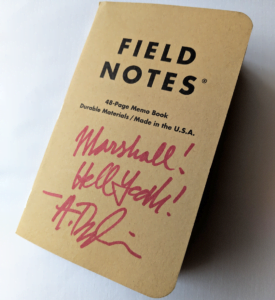
I’ve talked about Aaron Draplin before, as I signed up for his Field Notes after last falls SGIA Expo in Las Vegas. I almost pulled the trigger on those bad boys a few times over the years, as I like the iconic style and general purpose wit of this tool.
He is a fantastic designer, and what I’ve always liked about him best is that he stays true to the unique design language that he has set up for himself.
Fat lines.
Bold colors.
Boiling things down to the most simplistic elements.
If you design, then you know how incredibly difficult that is to do. His work is instantly recognizable.
In fact, he just created a new postage stamp.
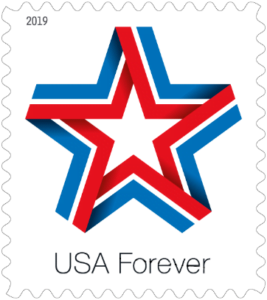
ThreadX offered a small workshop with Aaron on Sunday before the main festivities got rolling along. As a former, and still sometimes working designer, I opted to make sure my butt was in a seat for that one.
Here are a few takeaways that I think you could use.
Always On
The first takeaway is that he’s constantly working. And by constantly, I mean just that. He discussed the number of work requests he receives and it’s phenomenal. Although some projects are quite lucrative, he still does pro bono work, and even low-cost stuff if he believes in whatever you are doing.
He’s just that type of guy.
For Aaron, it is a privilege to work with people and interact. To be part of their story.
Earlier in the article, I mentioned engagement.
That’s what drives him I believe. Draplin told the crowd, “I’m not afraid to say yes. Some chances turn into bigger things.”
His best work is when he is fired up and engaged with the project.
He Likes Limitations
I’ve always believed that good design is problem-solving.
You have to know the rules and limitations. For him, almost all of his work is in Illustrator. It’s not that he isn’t trained in other software, but he can play better songs in a vector format with the instrument he knows the best.
He said, “I love the grid.” and I believe him.
“Don’t cloud things up. Keep it simple. Make it work in things that we’re forced to use, like the app store. If it works there, it will work anywhere.”
Furthermore, he is extremely organized. Flying through his Mac laptop, he was able to find any file from several years ago from his Dropbox account in only a few clicks. No search engine needed.
None of his work is on his computer. It’s all on the cloud.
He has it saved with this schema:
- Start with the year. Each folder is DDC19, DDC18, etc.
- Within that folder, are folders for his clients. NIKE, BURTON, THREADX, etc. He uses all caps.
- Within the client-folder is the file and version. Here’s his naming convention
- DDC19_THREADX19_LON
- DDC19_THREADX19_LON2
With this, he can find anything with a few simple clicks. He proved it by going back to files from years ago and instantly finding them without a search window.
Field Notes
Why did he start Field Notes way back when? Because he was constantly doodling out thumbnails for designs and other work and couldn’t find what he liked.
So he built his own.
Just hearing the tale of the work that went into that was worth the price of admission to ThreadX.
I appreciate good tools.
Field Notes is his ever-present creative journal and mind extension for Draplin. He wants to work on “the moves” of a design with a pen and paper first. Extend a part here, shorten a part there. Flip something around. Play with the negative space.
With a few precise pen strokes, he can orchestrate his thoughts on the design before moving to Illustrator.
Drawing.
How are his designs different and better than others? Most of them were crafted the old fashioned way. Not with a Google or Pinterest search for something to steal.
That’s what people pay for and value.
He Is Really Funny
When you look at a compendium of his work, there are little fun things inserted here and there.
But when he is on fire during a presentation, witty one-liners zip out. He’s the design world stand-up comedian.
You should have heard his riff on seeing Gene Simmons from Kiss at the airport.
“Hey, it’s Ted Nugent!”
Craftsmanship and History
He goes to garage sales and junk dealers to dig into stuff and find the tiny logos and ways people branded things years ago. Designs that can tell an entire story with one color. Little do-dads and things.
That inspiration of “how they used to do it”, works it’s way back into his thinking with design moves.
Are you a student of your craft?
Illustrator Tips
During his talk at ThreadX, he offered two Illustrator tips that I thought would make an impact.
- For shapes, logos, and things that you are constantly using import and save them into the Symbols Palette in Illustrator. Instead of having to go find the logo you are constantly using, just click the palette and it drops it on your artboard. Less clicking. Faster working.
- Go to New Document + Profiles and load up your shapes.
- Doing a lot of proofing? Build your own Pantone Chip box and save that into the Symbols Palette. When you need to add those to a presentation, just drag and drop them onto the artboard and add the right color.
ThreadX20
Next year’s ThreadX will be held in Scottsdale, Arizona.
Basically my backyard.
If you are reading this, I hope to see you there!
“Be respectful of the guys in the back.” – Aaron Draplin
“Keep room in your life for smaller projects.” – Aaron Draplin
“Don’t be intimidated by the white of the page. Just go.” – Aaron Draplin
Born At ThreadX
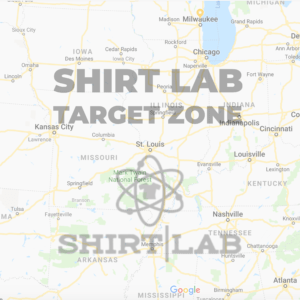
This time last year over some scrambled eggs and coffee at ThreadX in Palm Springs, Tom Rauen and I started a conversation about this industry.
That this industry needs more sales and marketing help. Tactical stuff that made sense.
A few months later we had a business plan and threw some money into a joint bank account.
Shirt Lab was born.
The entire day is about you. Making sure you have the latest best practices on a variety of sales and marketing topics. We’ve tagged the best instructors we could find to help deliver that promise. It is a workshop, which means interaction all day. There are tons of networking opportunities, so you can augment your industry Tribe.
But none of that matters unless you actually go. Get that knowledge and then implement it.
It’s there waiting for you like an orange on a tree.
Are you going to pick it and take a bite?
First up is Shirt Lab St. Louis – March 16, 2019 – general sales and marketing instruction
Into sports? Shirt Lab Washington DC – May 18, 2019 – athletic and team sales and marketing instruction
On the west coast? Shirt Lab Portland, OR – August 3, 2019 – general sales and marketing instruction
Got your own shirt brand? Shirt Lab Atlanta – September 28, 2019 – retail apparel line sales and marketing instruction
[av_button label=’Get Tickets’ link=’manually,https://shirtlabpro.com/’ link_target=’_blank’ size=’x-large’ position=’left’ label_display=” icon_select=’no’ icon=’ue800′ font=’entypo-fontello’ color=’theme-color’ custom_bg=’#444444′ custom_font=’#ffffff’ av_uid=’av-tujjf8′ admin_preview_bg=”]




